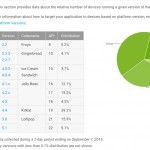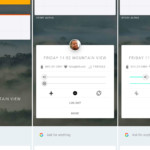Over 7,000 Bodies May Be Buried Beneath Mississippi University
In what sounds like a clichéd horror movie premise, a recent investigation suggests as many as 7, 000 bodies are buried across 20 acres at the Mississippi Medical Center Campus—the former site of the state’s first mental institution. Officials at the university now face the grim task of pulling 100-year-old bodies… Read more...
Reddit Users Lose Real Money After Meme Currency Bot Dies
Another day, another cryptocurrency clusterfuck. This week, the creator of the tipping bot “dogetipbot”—a service that let Reddit users “tip” each other in Dogecoin— announced that his company is broke, he’s broke, and the bot is broke because he spent all the coins, after he himself ran out of money. Read more...
Google’s mysterious Fuchsia OS looks like an Android re-do
When we last looked at Google's Fuchsia operating system , it was very modest. While it was designed for everything from Internet of Things devices to PCs, there wasn't even a graphical interface to show. Well, things have... evolved. Ars Technica has revisited Fuchsia several months later, and it now touts an interface (nicknamed Armadillo) that makes it clear this isn't just some after-hours experiment. It's only a set of placeholders at the moment, but it gives you a good idea as to what to expect. The home screen is a large, vertically scrolling list of cards for "stories, " or collections of apps and OS components that work together to complete a given task. There's also a Google Now -style section that has "suggestion" cards for tasks -- use them and you'll either add to an existing story or create a new one. The prototype UI also includes a simple split-screen interface, and scales up to tablet size. Fuchsia isn't based on Linux, like Android or Chrome OS, but it still uses open source code that would let anyone tinker with the inner workings. Apps, meanwhile, are built using Google's Flutter kit, which lets developers write both Android and iOS apps. Things are clearly coming along. But there's one overriding question: just what role will Fuchsia have? Google's Travis Geiselbrecht stresses that this "isn't a toy thing, " but there's no public strategy. Ars speculates that Google is treating this as a sort of Android re-do: what if the company could design a platform while dumping all the technology it no longer needs or wants, such as Linux or any traces of Java ? The use of Flutter would let you run Android apps until there's broader software support. It might take years before Fuchsia is ready for public use, assuming that's the ultimate plan, but there could be a day where Android is no longer the center of Google's computing universe. Source: Ars Technica
Harley-Davidson embraces the potential of electric motorcycles
Bikers interested in going green have reason to rejoice today. Harley-Davidson has already shown off its prototype Livewire electric bike, and it's promised to offer you a real one in the next five years . Today, the motorcycle manufacturer said it has plans to make 100 new motorcycles over the next 10 years, including an entire range of electric vehicles. Vice president Bill Davidson confirmed that electric bikes are Harley-Davidson's future to Drive magazine while in Sydney to celebrate the brand's 100th anniversary in Australia. While an electric Harley won't have the signature engine boom that its combustion-powered bikes have, Davidson said that the company is working on a sound that he likens to a jet engine. "It is an amazing motorcycle, " he told Drive . "While it doesn't have a 45-degree, pushrod twin-cylinder engine it has the performance expected from a Harley Davidson even if it won't sound the same, " he said. So far, we've only seen the one Livewire concept model with a limited top speed and range, it's likely thHarleyely-Davidson will create both sport and cruiser-style bikes to appeal to both the speed freaks and the touring bikers. Davidson noted that as automated cars become more ubiquitous, driving enthusiasts may turn to motorcycles to get their manual fix, telling Drive , "I think the more automatic cars [happen], motorcycling will become more appealing. I see it as a huge opportunity." Via: Autoblog Source: Drive
Google’s mysterious Fuchsia OS looks like an Android re-do
When we last looked at Google's Fuchsia operating system , it was very modest. While it was designed for everything from Internet of Things devices to PCs, there wasn't even a graphical interface to show. Well, things have... evolved. Ars Technica has revisited Fuchsia several months later, and it now touts an interface (nicknamed Armadillo) that makes it clear this isn't just some after-hours experiment. It's only a set of placeholders at the moment, but it gives you a good idea as to what to expect. The home screen is a large, vertically scrolling list of cards for "stories, " or collections of apps and OS components that work together to complete a given task. There's also a Google Now -style section that has "suggestion" cards for tasks -- use them and you'll either add to an existing story or create a new one. The prototype UI also includes a simple split-screen interface, and scales up to tablet size. Fuchsia isn't based on Linux, like Android or Chrome OS, but it still uses open source code that would let anyone tinker with the inner workings. Apps, meanwhile, are built using Google's Flutter kit, which lets developers write both Android and iOS apps. Things are clearly coming along. But there's one overriding question: just what role will Fuchsia have? Google's Travis Geiselbrecht stresses that this "isn't a toy thing, " but there's no public strategy. Ars speculates that Google is treating this as a sort of Android re-do: what if the company could design a platform while dumping all the technology it no longer needs or wants, such as Linux or any traces of Java ? The use of Flutter would let you run Android apps until there's broader software support. It might take years before Fuchsia is ready for public use, assuming that's the ultimate plan, but there could be a day where Android is no longer the center of Google's computing universe. Source: Ars Technica
This Synthetic Bone Implant Could Replace Painful Marrow Transplants
Thanks to advances in medicine, bone marrow transplants are no longer the last resorts they one were. Every year, thousands of marrow transplants are performed, a common treatment for ailments from bone marrow disease to leukemia. But because they first require a patient undergo radiation to kill off any existing bone… Read more...
Massive ransomware attack hits UK hospitals, Spanish banks
Enlarge (credit: Health Service Journal) A large number of hospitals, GPs, and walk-in clinics across England have been locked down by a ransomware attack, reports suggest. There are also some reports of a ransomware attack hitting institutions in Portugal and Spain, though it isn't known if the incidents are connected. NHS England says it is aware of the issue, but hasn't yet issued an official statement. At this point it isn't clear whether a central NHS network has been knocked offline by the ransomware, or whether individual computers connected to the network are being locked out. In any case, some hospitals and clinics are reporting that their computer systems are inaccessible and some telephone services are down too. Read 7 remaining paragraphs | Comments
Ubuntu Arrives in the Windows Store, Suse and Fedora Are Coming To the Windows...
At its Build developer conference today, Microsoft announced that Ubuntu has arrived in the Windows Store. From a report: The company also revealed that it is working with Fedora and Suse to bring their distributions to the Windows Subsystem for Linux (WSL) in Windows 10. At the conference last year, Microsoft announced plans to bring the Bash shell to Windows. The fruits of that labor was WSL, a compatibility layer for running Linux binary executables (in ELF format) natively on Windows, which arrived with the Windows 10 Anniversary Update released in August 2016. Microsoft also partnered with Canonical to allow Ubuntu tools and utilities to run natively on top of the WSL. By bringing Ubuntu to the Windows Store, the company is now making it even easier for developers to install the tools and run Windows and Linux apps side by side. Working with other Linux firms shows that Microsoft's deal with Canonical was not a one-time affair, but rather part of a long-term investment in the Linux world. Read more of this story at Slashdot.
Watching two waves of hot lava in the Solar System’s largest volcano
Enlarge / Loki Patera, in the lower-center, has a central island that divides two waves of molten material. (credit: NASA/JPL/USGS ) Volcanic activity appears to be a common feature in our Solar System; we have evidence of it on three planets and two moons and hints of it elsewhere. But that doesn't mean all volcanic activity is the same. Venus' activity is driven by a simple version of plate tectonics. On the Moon, massive lava flows were released by large impacts, and Mars just seems to have vented heat left over from its formation. There are also hints of cryovolcanoes, which belch up ice rather than lava, on some of the bodies of the outer Solar System. But when it comes to sheer volume of activity, all of this takes a back seat to Jupiter's moon Io. Io is partially molten due to gravitational stress from its proximity to three large moons and a massive planet. The results are active volcanoes and vast pools of molten material on the Moon's surface. And we just got a good look inside the biggest of them. Slicing up Loki Loki Patera is the most powerful active volcano in the Solar System. It's an enormous crater with a central island; around that island is a sea of hot material that covers more than 20,000 square kilometers. By all appearances, that hot material isn't stable, since the entire surface seems to be reworked every few years, temporarily replaced by new hot material. Read 10 remaining paragraphs | Comments
A single autonomous car could greatly reduce man-made traffic
Traffic. We all hate it, but what can honestly be done to significantly reduce it? Well, according to an experiment conducted by the university of Illinois, simply introducing a few self-driving cars to roads could be the answer. Conducting experiments in Tucson, Arizona the team discovered that even adding a single autonomous vehicle to the roads can massively reduce traffic. They programmed a self-driving car to loop a track continuously and then added 20 other human-driven cars to the mix. While humans somehow naturally create stop-and-go traffic even without lane changes or other disruptions, thanks to the robotic racer, both traffic and fuel consumption were reduced by 40 percent. This isn't the first example of modern tech helping to reduce congestion. With fixed traffic sensors widely swapped for navigation systems using GPS data, Professor Daniel B. Work believes that automated cars could be the next step -- replacing the traffic-reducing variable speed limits. The next stage of the experiment is to test autonomous cars in situations where both human and AI drivers have to change lanes. From our experience with freeways, we already feel bad for the robot cars. Still, this isn't the only way that drivers can use automation to reduce traffic. With the margin of human error being so high, the same study suggests that even existing tech like adaptive cruise control has the power to greatly reduce the amount of traffic on our roads. With many people understandably wary at the prospect of roads completely ruled by automated cars, the idea of mixing a few with regular vehicles seems like a good way to pilot the risky tech. Via: Phys.org Source: Cornell University Library










